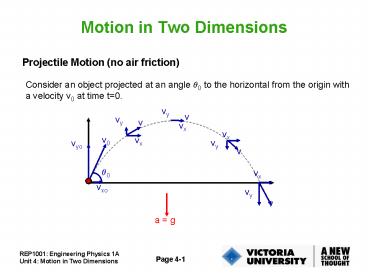Motion in Two Dimensions - PowerPoint PPT Presentation
1 / 13
Title:
Motion in Two Dimensions
Description:
Projectile Motion (no air friction) ... Projectile Motion. Vertical motion is under uniform vertical acceleration. ... Projectile Motion. Question: What is the ... – PowerPoint PPT presentation
Number of Views:607
Avg rating:3.0/5.0
Title: Motion in Two Dimensions
1
Motion in Two Dimensions
- Projectile Motion (no air friction)
Consider an object projected at an angle q0 to
the horizontal from the origin with a velocity v0
at time t0.
vy
v
vy
v
vx
vx
v0
vx
vy
vyo
v
q0
vx
vxo
vy
v
a g
2
Projectile Motion
- Projectile Motion (no air friction)
For the initial velocity, the two components of
velocity are
Vertical velocity vy0 vosinq0
Horizontal velocity vx0 vocosq0
Both components obey the laws of rectilinear
motion.
3
Projectile Motion
- Vertical motion is under uniform vertical
acceleration.
- Vertical velocity vy vy0 - gt vosinq0 - gt
- Vertical displacement y y0 vot - ½.gt2
v0sinq0t - ½.gt2
- Horizontal motion has no acceleration constant
speed.
- Horizontal velocity vx vx0 vocosq0
constant
- Horizontal displacement x x0 vx0t v0cosq0t
- Velocity at any time is v vy2 vx21/2 at an
angle q given by tanqvy/vx
- Combining displacement equations give
4
Projectile Motion
- Example A ball is thrown from the top of a 125 m
cliff at a speed of 65.0 m/s at 37o above the
horizontal.
5
Projectile Motion
- Question How long is the ball in flight?
What do we know?
Initial horizontal velocity v0x 65cos(37o)
51.9 m/s
Initial vertical velocity v0y 65sin(37o)
39.1 m/s
Displacement is y -125 m (assuming origin at
point of projection)
Acceleration a - 9.8 m/s2 (taking upward
direction as ve)
Use
For our example
or
Solutions is t 10.43 s, or t -2.45 s
Answer is t 10.43 s
6
Projectile Motion
Question What is the range of the ball, ie. what
is x?
Use same equation
now that we know t
7
Projectile Motion
- Example A stunt man drives his car up a ramp
inclined at 30o to the ground and lands on a ramp
of the same height 20 m away from the launch
ramp. What is the minimum speed needed for the
stunt man to clear this distance and make it
safely to the other side? Give your answer in
kms/hr.
Answer 54.2 kms/hr.
8
Uniform Circular Motion
- A body moving with constant speed in a circular
motion is uniformly accelerating- - - magnitude of velocity is constant but
- - direction is changing at a constant rate -gt
constant acceleration.
For circular motion the acceleration is directed
towards the centre of the circle-
9
Uniform Circular Motion
- Linear Displacement.
A
v1
?l
B
v2
r
r
Displacement from A to B is l
where l rq (q is in radians)
10
Uniform Circular Motion
- Linear Velocity.
If an object travels a distance Dl in time Dt
whilst tracing out an angle Dq
A
v1
The linear velocity is
?l
B
v2
r
Because r is constant
r
where w is the angular speed (radians/second)
11
Uniform Circular Motion
- Acceleration (with constant speed).
A
v1
The acceleration is
?l
B
v2
ar
Since v is constant, thus
r
r
Acceleration is radially inwards - centripetal
acceleration
12
Uniform Circular Motion
- Example 1 In the spin-cycle of a washing machine
the tub, radius 0.3 m, develops a speed of 630
rpm. What is the maximum linear speed with which
the water leaves the tub?
What do we know?
What are we looking for?
radius r 0.3 m
Linear velocity v
Angular speed 630 rpm
Need to convert angular speed from rpm to
radians/second
Linear velocity is then
13
Uniform Circular Motion
- Example 2 Compute the linear speed of a person
on the surface of the earth at the equator, and
its centripetal acceleration? rearth 6.37x106 m
What do we know?
What are we looking for?
radius r 6.37x106 m
Linear velocity v
Angular speed 24 hrs per revolution
Centripetal acceleration ar
Circumference of the earth is 2pr 2 x p x
6.37x106 m
Linear speed is v circumference/period of
rotation
v 463 m/s
Centripetal acceleration is
ar 0.034 m/s2































